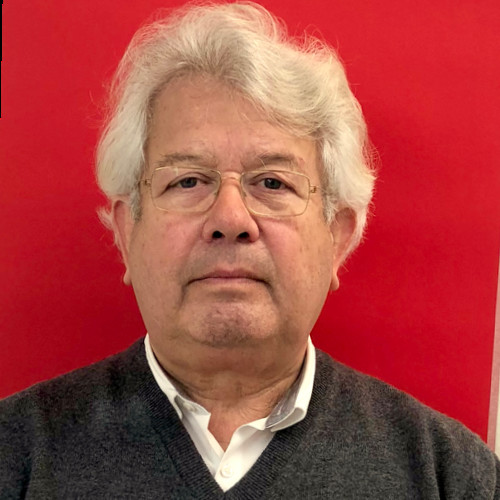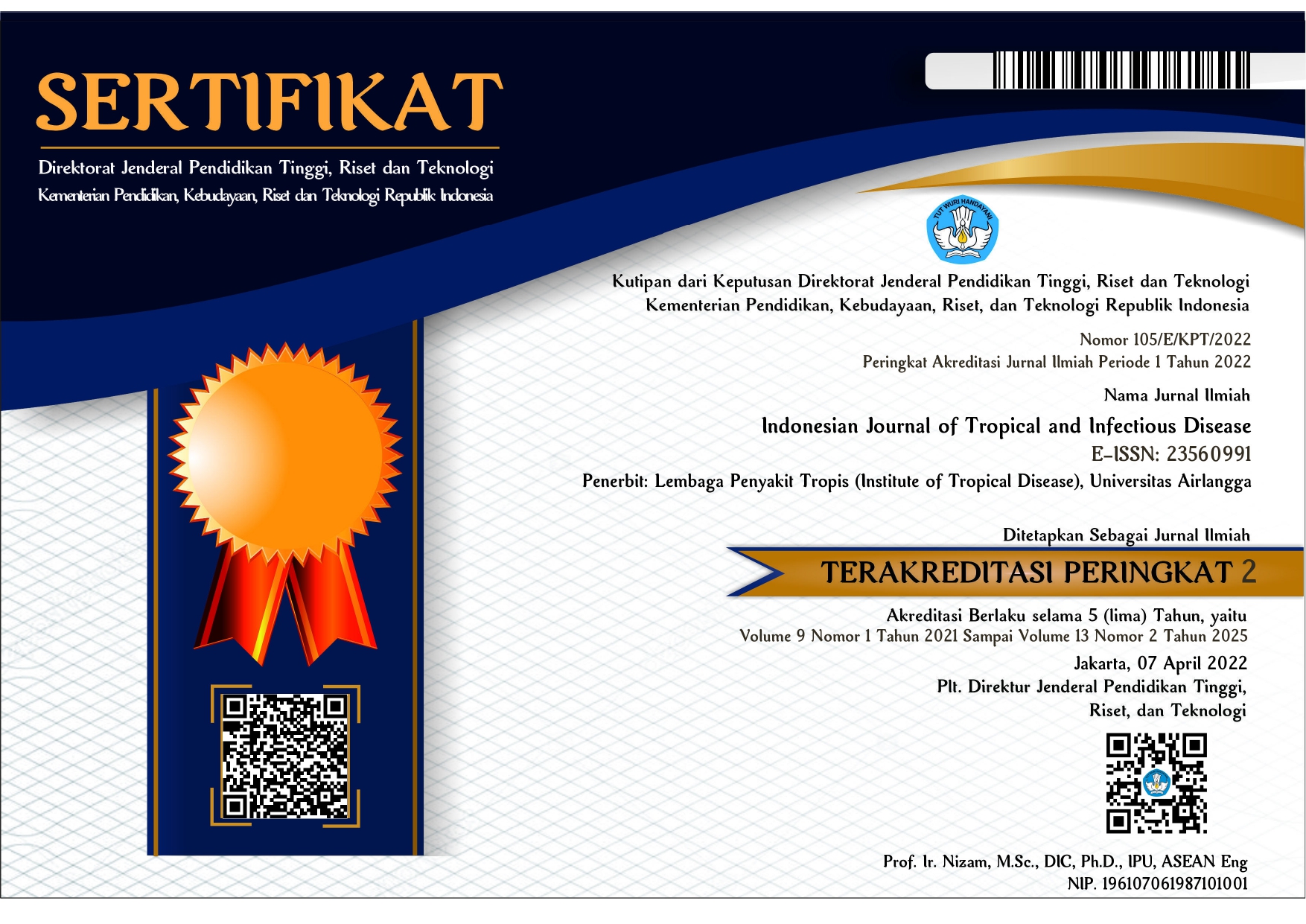New Biotype of Vibrio cholerae O1 from Clinical Isolates in Surabaya
Downloads
A surveillance of new pathogenic variants of Vibrio cholerae O1 strains was initiated to identify the emerge and spread throughout Surabaya. Findings from seven years (1994–2000) and from years 2008 until now by using a two-fold surveillance strategy was pursued involving 1) hospital-based case recognition, and 2) environment samples. Rectal swabs and environment samples were transported to ITD-UNAIR, Surabaya for culture and isolates were characterized by serotypic identification and arbitrarily primed PCR fingerprints revealed a group of strains with similar fingerprint patterns that are distinct from those of the current El Tor epidemic strain. These strains have been analyzed by in vitro technique and the group has been denominated the Surabaya-Indonesian variant of V. cholerae O1.
Barua, D. 1974. Laboratory diagnosis of cholera, p. 85–126. In D. Barua and W. Burrows (ed.), Cholera. The W. B. Saunders Co., Philadelphia.
Bauer, A. W., W. M. M. Kirby, J. C. Sherris, and M. Turck. 1966. Antibiotic susceptibility testing by a standardized single disk method. Am. J. Clin. Pathol. 45:493–496.
Coelho, A., A. Vicente, H. Momen, and C. Salles. 1993. Typing of Vibrio cholerae using arbitrary primers, p. 211. Volume of abstracts. Seventeenth International Congress of Genetics, Birmingham, United Kingdom. The Quadgraphics Partnership, Thatcham, United Kingdom.
Coelho, A., A. C. P. Vicente, M. A. S. Baptista, H. Momen, F. R. W. dos Santos, and C. A. Salles. 1995. The distinction of pathogenic Vibrio cholerae groups using arbitrarily primed PCR fingerprints. The Quadgraphics Partnership, Thatcham, United Kingdom.
Coelho, A., O. R. Joa., C. Andrade., A. C. P. Vicente, and C. S. A. Salles. 1995. New Variant of Vibrio cholerae O1 from Clinical Isolates in Amazonia. Journal Of Clinical Microbiology. 33:114–118.
Clinical and Laboratory Standards Institute. 2008. Performance Standards for Antimicrobial Susceptibility Testing; Eighteenth Informational Supplement. M100-S18. 28:74–76.
DiRita, V., C. Parsot, G. Jander, and J. J. Mekalanos. 1991. Regulatory cascade controls virulence in Vibrio cholerae. Proc. Natl. Acad. Sci. USA 88: 5403–5407.
Faruque, S.M., D.A Sack, R.B Sack, R.R Colwell, Y. Takeda and G.B Nair. 2003. Emergence and evolution of Vibrio cholerae O139. Proceedings of the National Academy of Sciences of the United States of America. Volume 100, Issue 3. pp 1304–1309.
Hayashi S, M. Okura, R. Osawa. 2006. Soft-agar-coated filter method for early detection of viable and thermostable direct hemolysin (TDH)-or TDH-related hemolysin-producing Vibrio parahaemolyticus in seafood. Appl Environ Microbiol, 72:4576–4582.
Higgins, D. E., E. Nazareno, and V. J. DiRita. 1992. The virulence gene activator ToxT from Vibrio cholerae is a member of the AraC family of transcriptional activators. J. Bacteriol. 174:6974–6980.
Iwanaga, M., and K. Yamamoto. 1985. New medium for the
production of cholera toxin by Vibrio cholerae O1 biotype El Tor. J. Clin. Microbiol. 22:405–408.
Jonson, G., J. Holmgren, and A.-M. Svennerholm. 1991. Identification of a mannose-binding pilus on Vibrio cholerae El Tor. Microb. Pathog. 11:433–441.
Jonson, G., J. Sanchez, and A.-M. Svennerholm. 1989. Expression and detection of different biotype-associated cell-bound haemoagglutinins of Vibrio cholerae O1. J. Gen. Microbiol. 135:111–120.
Keasler, S. P., and R. H. Hall. 1993. Detecting and biotyping Vibrio cholerae O1 with multiplex polymerase chain reaction. Lancet 341:1661.
Koblavi, S., F. Grimont, and P. A. D. Grimont. 1990. Clonal diversity of Vibrio cholerae O1 evidenced by rRNA gene restriction patterns. Res. Microbiol. 141:645–657.
Lan, R., and P. R. Reeves. 2002. Pandemic Spread of Cholera: Genetic Diversity and Relationships within the Seventh Pandemic Clone of Vibrio cholerae Determined by Amplified Fragment Length Polymorphism. JCM. 40:172-181.
Lipp,E. K., I. N. G. Rivera, A. I. Gil, E. M. Espeland, .N. Choopun, V. R. Louis, E. R. Cohen, A. Huq, and R. R. Colwell. 2003. Direct Detection of Vibrio cholerae and ctxA in Peruvian Coastal Water and Plankton by PCR. Applied and Environmental Microbiology. 69: 3676–3680.
Louis, V. R., E. R. Cohen, N. Choopun, I. N. G. Rivera, B. Gangle, S. C. Jiang, A. Rubin, J. A. Patz, A. Huq, and R. R. Colwell. 2003. Predictability of Vibrio cholerae in Chesapeake Bay. Applied and Environmental Microbiology. 69:2773–2785.
Ogawa, A., J.-I. Kato, H. Watanabe, B. G. Nair, and T. Takeda. 1990. Cloning and nucleotide sequence of a heat-stable enterotoxin gene from Vibrio cholerae non-O1 isolated from a patient with traveler's diarrhea. Infect. Immun. 58:3325–3329.
Oneshchenko G. G, I. M. Lomov, E. A. Moskvitina, I. M. Fedorov, L.S. Podosinnikova, A. V. Gorobets. 2005. Cholera at the beginning of the XXI century. Prognosis. Zhurnal Mikrobiologii Epidemiologii i Immunobiologii. pp. 44-48.
Popovic, T., C. Bopp, í˜. Olsvik, and K. Wachsmuth. 1993. Epidemiologic application of a standardized ribotype scheme for
Vibrio cholerae O1. J. Clin. Microbiol. 31:2474–2482.
Roy, C., K. Mridha, and S. Mukerjee. 1965. Action of polymyxin of cholera vibrios: techniques of determination of polymyxin-sensitivity. Proc. Soc. Exp. Biol. Med. 119:893–896.
Salles, C. A., H. Momen, A. Coelho, E. F. de Oliveira, A. C. P.
Vicente, and G. B. Nair. 1994. Bengal: El Tor cholera Vibrio in a
new robe. Mem. Inst. Oswaldo Cruz 89:115–116.
Salles, C. A., H. Momen, A. C. P. Vicente, and A. Coelho. 1993. Vibrio cholerae in South America: polymerase chain reaction and zymovar analysis. Trans. R. Soc. Trop. Med. Hyg. 87:272.
Sambrook, J., E. F. Fritsch, and T. Maniatis. 1989. Molecular cloning: a laboratory manual, 2nd. ed. Cold Spring Harbor Laboratory Press, Cold Spring Harbor, N.Y.
Safa A, Nair G.B, Kong R.Y.C. 2010. Trends in Microbiology.
:46–54.
Silhavy, T. J., M. L. Berman, and L. W. Enquist. 1994. Experiments with gene fusions, pp. 137–139. Cold Spring Harbor Laboratory Press, Cold Spring Harbor, N.Y.
Simanjuntak, C. H., W. Larasati, S. Arjoso, Maidy Putri, M. Lesmana, B. A. Oyofo, N. Sukri, D. Nurdin, R. P. Kusumaningrum, N. H. Punjabi, D. Subekti, S. Djelantik, Sukarma, Sriwati, Muzahar, A. Lubis, H. Siregar, B. Mas'ud, M. Abdi, A. Sumardiati, S. Wibisana, Hendarwanto, B. Setiawan, W. Santoso, Eka Putra, S. Sarumpaet, H. Ma'ani, C. Lebron, S. A. Soeparmanto, J. R. Campbell, and A. L. Corwin. 2001. Cholera In Indonesia In 1993–1999. Am. J. Trop. Med. Hyg., 65: 788–797.
Tauxe, R., L. Seminario, R. Tapia, and M. Libel. 1994. The Latin American epidemic, p. 321–344. In I. K. Wachsmuth, P. A. Blake, and í˜. Olsvik (ed.), Vibrio cholerae and cholera. American Society for Microbiology, Washington, D.C.
Welsh, J., and M. McClelland. 1990. Fingerprinting genomes using PCR with arbitrary primers. Nucleic Acids Res. 18:7213–7218.
Williams, J. G. K., A. R. Kubelik, K. J. Livak, J. A. Rafalski, and S. V. Tingey. 1990. DNA polymorphisms amplified by arbitrary primers are useful as genetic markers. Nucleic Acids Res. 18:6531–6535.
Yamamoto, K., Y. Takeda, T. Miwatani, and J. P. Craig. 1983.
Purification and some properties of a non-O1 Vibrio cholerae
enterotoxin that is identical to cholera enterotoxin. Infect. Immun. 39:1128–1135.
Yamazaki, W., K. Seto, M. Taguchi, M. Ishibashi and K. Inoue. 2008. Sensitive and rapid detection of cholera toxin-producing Vibrio cholerae using a loop-mediated isothermal amplification. BMC Microbiology, 8:94.
The Indonesian Journal of Tropical and Infectious Disease (IJTID) is a scientific peer-reviewed journal freely available to be accessed, downloaded, and used for research. All articles published in the IJTID are licensed under the Creative Commons Attribution-NonCommercial-ShareAlike 4.0 International License, which is under the following terms:
Attribution ” You must give appropriate credit, link to the license, and indicate if changes were made. You may do so reasonably, but not in any way that suggests the licensor endorses you or your use.
NonCommercial ” You may not use the material for commercial purposes.
ShareAlike ” If you remix, transform, or build upon the material, you must distribute your contributions under the same license as the original.
No additional restrictions ” You may not apply legal terms or technological measures that legally restrict others from doing anything the license permits.























